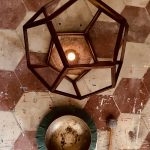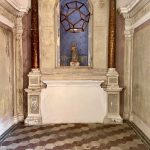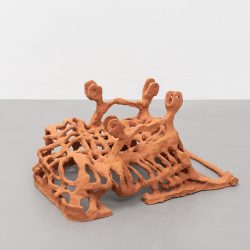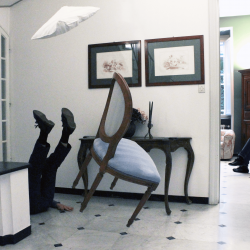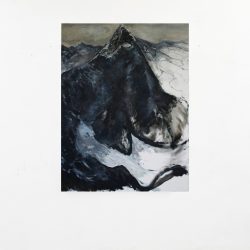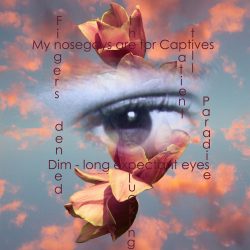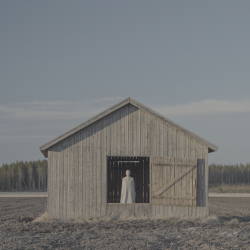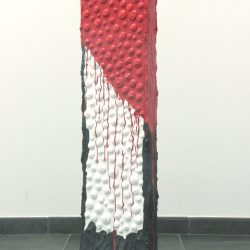work
Shiné
| category | Sound art |
| subject | Nature, Beauty, Abstract |
| tags | https://www.matteosilva.eu/installations |
| minutes | 21 |
| seconds | 20 |
| year | 2023 |
Shiné: A way Inside
Shiné, a way Inside is an installation created in 2023, ideal, with its particular variations, for spaces of spiritual relevance, such as churches, chapels, caves, dojos, temples and adequate art galleries.
The installation includes 21-minute sessions, in which 2/4/8/ or 16 spectators can participate depending on the size of the space. Each session is governed by the recorded soundtrack which is broadcast in high definition from a minimum of 2 to a maximum of 5 speakers. During the session each spectator has the right to stand up and strike the Tibetan bowl placed in front of him one to three times. This ancient bowl is the instrument with which the soundtrack was created. Once the session is over, participants/visitors can rise and make way for others or stay for another 21 minute session. Each visitor can freely leave before the end of the session but not before having left with one, two or three strikes on the bowl. Between each session there is a 3 minutes break. Once exited, the participant can no longer re-enter the same session. Upon leaving, visitors/participants will be invited to write a short comment in a guests’ book.
Shiné is an analogue multimedia installation whose aim is to slow down the heartbeat of participants and induce them to contemplation. Shiné is a Tibetan term which can be divided into two syllables, the first “shi” means tranquil and “né”, abiding. So shiné is tranquil or calming and abiding in that which is. Shiné is practised within meditation in several ways; the most common way is that of focusing on one’s breath, or, alternatively, on Sound.
Shiné and Laktong in Tibetan, or Shamata and Vipassana in Sanskrit, are the two primary components or inner standings that are practised within the framework of most Buddhist traditions. I deliberately chose the Tibetan term and not the Sanskrit one as a tribute to the peaceful Tibetan culture, a precious treasure of humanity in danger of extinction, and for which reason instead of using electronic sounds, the "oldest electronics" or the natural sounds of Tibetan resonant bowls were used.
Another element of the installation is a geometric figure, the dodecahedron. A regular dodecahedron, such as the one or the many used for these installations has 12 congruent faces that are regular pentagons, 30 congruent edges, and 20 vertices; an edge is a line segment formed by the intersection of two adjacent faces; a vertex for a regular dodecahedron is a point where 3 edges meet. Regular dodecahedrons are one of five Platonic solids, which are a type of regular polyhedron. Plato used a dodecahedron as the quintessence to describe the cosmos. Plato's model was the universe as a geometric progression with a Lesser and Greater Mystery -- Phi and the Dodecahedron. A visual representation of higher consciousness, the god-image of the cosmos as a dodecahedron, the basic unit of the universe, recurs again and again. The dodecahedron was and still is a vessel of secrets.
The video and photos are only a small sample, and illustrate an installation carried out in the chapel of the Hermitage of San Michele Arcangelo in Todi, in August of 2023.
Shiné, a way Inside is an installation created in 2023, ideal, with its particular variations, for spaces of spiritual relevance, such as churches, chapels, caves, dojos, temples and adequate art galleries.
The installation includes 21-minute sessions, in which 2/4/8/ or 16 spectators can participate depending on the size of the space. Each session is governed by the recorded soundtrack which is broadcast in high definition from a minimum of 2 to a maximum of 5 speakers. During the session each spectator has the right to stand up and strike the Tibetan bowl placed in front of him one to three times. This ancient bowl is the instrument with which the soundtrack was created. Once the session is over, participants/visitors can rise and make way for others or stay for another 21 minute session. Each visitor can freely leave before the end of the session but not before having left with one, two or three strikes on the bowl. Between each session there is a 3 minutes break. Once exited, the participant can no longer re-enter the same session. Upon leaving, visitors/participants will be invited to write a short comment in a guests’ book.
Shiné is an analogue multimedia installation whose aim is to slow down the heartbeat of participants and induce them to contemplation. Shiné is a Tibetan term which can be divided into two syllables, the first “shi” means tranquil and “né”, abiding. So shiné is tranquil or calming and abiding in that which is. Shiné is practised within meditation in several ways; the most common way is that of focusing on one’s breath, or, alternatively, on Sound.
Shiné and Laktong in Tibetan, or Shamata and Vipassana in Sanskrit, are the two primary components or inner standings that are practised within the framework of most Buddhist traditions. I deliberately chose the Tibetan term and not the Sanskrit one as a tribute to the peaceful Tibetan culture, a precious treasure of humanity in danger of extinction, and for which reason instead of using electronic sounds, the "oldest electronics" or the natural sounds of Tibetan resonant bowls were used.
Another element of the installation is a geometric figure, the dodecahedron. A regular dodecahedron, such as the one or the many used for these installations has 12 congruent faces that are regular pentagons, 30 congruent edges, and 20 vertices; an edge is a line segment formed by the intersection of two adjacent faces; a vertex for a regular dodecahedron is a point where 3 edges meet. Regular dodecahedrons are one of five Platonic solids, which are a type of regular polyhedron. Plato used a dodecahedron as the quintessence to describe the cosmos. Plato's model was the universe as a geometric progression with a Lesser and Greater Mystery -- Phi and the Dodecahedron. A visual representation of higher consciousness, the god-image of the cosmos as a dodecahedron, the basic unit of the universe, recurs again and again. The dodecahedron was and still is a vessel of secrets.
The video and photos are only a small sample, and illustrate an installation carried out in the chapel of the Hermitage of San Michele Arcangelo in Todi, in August of 2023.



